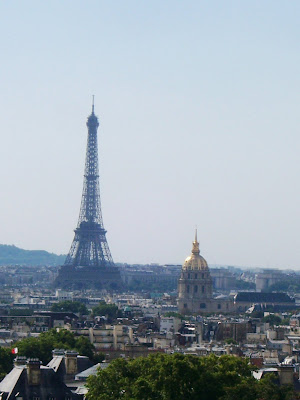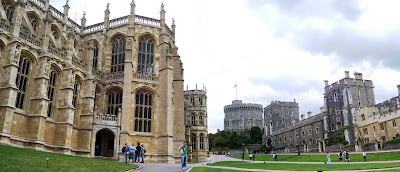This past weekend I took the train to Salisbury in the southwest of England. Known for it's beautiful Cathedral (with the tallest spire in the UK), Salisbury sits on the edge of the famous Salisbury Plain. Trains depart just about every half hour from Waterloo Station in London and arrive at Salisbury in about an hour and a half. After getting there I made my way to the city center. Salisbury must be the easiest, best marked city I've been to in the UK. There were signs everywhere, it would be almost impossible to lose your way. Once in the city center I grabbed a quick breakfast and stopped by the tourism office. They offer a cheap 2-hour walking tour which was leaving in a few minutes, so I signed up. The tour was good, although the guide was a little old and hard to hear. The tour was for the city and not the Cathedral or Cathedral Close (though we walked through part of it), so I'm glad I took it or I would have missed out on a lot. We ended up going into quite a few historic buildings that had been converted into hotels or restaurants. They were really interesting and I wouldn't have gone in them without the guide who apparently had an agreement with the owners.
One of the first places we went to was the Church of St. Thomas (below). The outside is nothing amazing, and really, neither is the inside except for the painting in the church called
Doom. When our tour went by the church was closed for some kind of service, so I had to swing back by on my own a little later. It was well worth it though. The church was completely empty, which allowed me to sit down and look at the painting in my own time. It was a gift from a pilgrim and depicts Judgement Day, with people crawling out of their graves and either being taken to heaven or being dragged by demons to hell. It was kind of nice to sit alone and look at this medieval pilgrim's view of Judgement Day; knowing that generations of people have sat in the same pews, looked at
Doom and pondering the same ideas that it brings to your mind. The second picture below is of the painting, although I couldn't get a clear shot to come out.


The tour conveniently ended in front of the Salisbury Cathedral, so I decided to go in. It was built from 1220 to 1258, very quick for a Cathedral which means that it was all done in one style, English Gothic. Normally, since Cathedrals take so long to build, they end up incorporating several different styles. The Cathedral is free to enter, but they do ask for a donation. People told me they could be quite pushy about it, because the upkeep of the Cathedral is considerable. I wasn't asked to make a donation, although I did put one in the box, but I heard them being kind of pushy with the people in front of me. Maybe they didn't bother because I'm foreign, or maybe because I bought one of the small guides. But the lady at the desk kept asking the people in front of me, "Would you like to make a donation", and when he said no they said, "Really!?! The upkeep is extremely expensive, you really can't spare a donation?". It seemed a bit pushy to me anyways, but the people just kept refusing and became a little exasperated. Although you probably should donate something, since it costs something like 12,ooo pounds a day to upkeep the Cathedral.
The first picture below is of the Cathedral's spire. Below that is a short video from inside the Cathedral. It was very atmospheric, a choir was practicing in the Cathedral (you should be able to hear in the video).

 The Cathedral also houses one of the four copies of the Magna Carta. It's been at the Cathedral since 1225 and was pretty neat to see. The photo below is of some of the military flags in the Cathedral. It seems like almost every church and cathedral that I've visited in the UK, large or small, has the historic flags of the nearby/local military units. For a history fanatic, it is always interesting to see the flags that accompanied these units to the far flung reaches of the British Empire. Oftentimes the flags will have a plaque or sign saying where it was used, from China to the Crimea.
The Cathedral also houses one of the four copies of the Magna Carta. It's been at the Cathedral since 1225 and was pretty neat to see. The photo below is of some of the military flags in the Cathedral. It seems like almost every church and cathedral that I've visited in the UK, large or small, has the historic flags of the nearby/local military units. For a history fanatic, it is always interesting to see the flags that accompanied these units to the far flung reaches of the British Empire. Oftentimes the flags will have a plaque or sign saying where it was used, from China to the Crimea.

After the Cathedral I made my way to the bus station and got tickets for a line that runs a loop between Salisbury, Stonehenge and Old Sarum. It ended up being a really good deal. It only cost around 14 pounds, which included entry into Stonehenge. Of course there are huge lines when you get there, but the bus driver walked us through the side gate so we didn't have to wait.
By now, everyone knows how interested I am in history. But for whatever reason, Stonehenge never was a huge draw for me. Maybe because I assumed there wasn't much there and that it would be packed with people. This was the case, but it ended up being much better than I thought. It is always cool when you finally see something that you've seen on TV or read about. And the mystery and atmosphere of the place is kind of striking. Set on the Salisbury Plain, Stonehenge really was a fantastic sight. Another interesting thing was the large burial mounds in the fields nearby. You could tell that they were made in different shapes and, as it turns out, this was the case. Different shaped mounds were used for men and women.


Stonehenge really doesn't take too long, so I hopped back on the bus and road to Old Sarum. The bus ticket price included admission into Old Sarum as well as Stonehenge. This was the site of the earliest settlement of Salisbury. In fact, Salisbury has historically been referred to as New Sarum. It has been a site of human habitation since 3000 BC, but its first major development was during the Iron Age when it was built up as a hill fort. You can see from the photo below that, on top of being on a hill surrounded by plains, it has been built into a impressive fortification. It was occupied by the Romans, Saxons and eventually the Normans. The Normans built a large castle on the site, but only the foundations remain. William the Conqueror actually disbanded and paid out his army here following his conquest of England. The second photo below is looking towards Salisbury from Old Sarum, you can see the Cathedrals spire through the fog.


After getting back to Salisbury from Old Sarum I wandered around the market, then just as it was starting to rain (again) made my way to the train station. I really enjoyed my day at Salisbury, it's a nice little town and has quite a bit to offer.







































 The Cathedral also houses one of the four copies of the Magna Carta. It's been at the Cathedral since 1225 and was pretty neat to see. The photo below is of some of the military flags in the Cathedral. It seems like almost every church and cathedral that I've visited in the UK, large or small, has the historic flags of the nearby/local military units. For a history fanatic, it is always interesting to see the flags that accompanied these units to the far flung reaches of the British Empire. Oftentimes the flags will have a plaque or sign saying where it was used, from China to the Crimea.
The Cathedral also houses one of the four copies of the Magna Carta. It's been at the Cathedral since 1225 and was pretty neat to see. The photo below is of some of the military flags in the Cathedral. It seems like almost every church and cathedral that I've visited in the UK, large or small, has the historic flags of the nearby/local military units. For a history fanatic, it is always interesting to see the flags that accompanied these units to the far flung reaches of the British Empire. Oftentimes the flags will have a plaque or sign saying where it was used, from China to the Crimea. 














